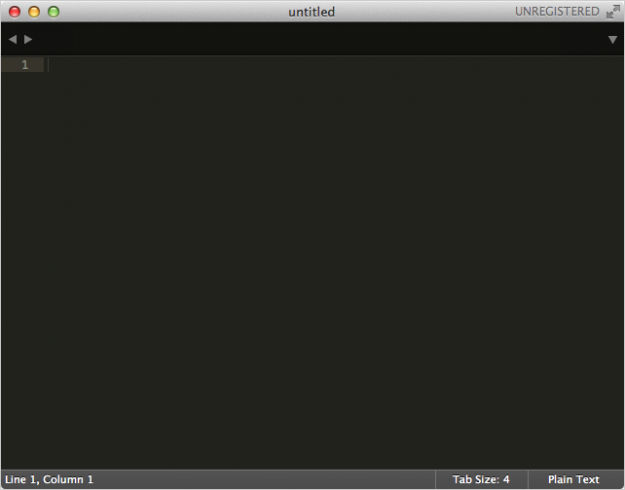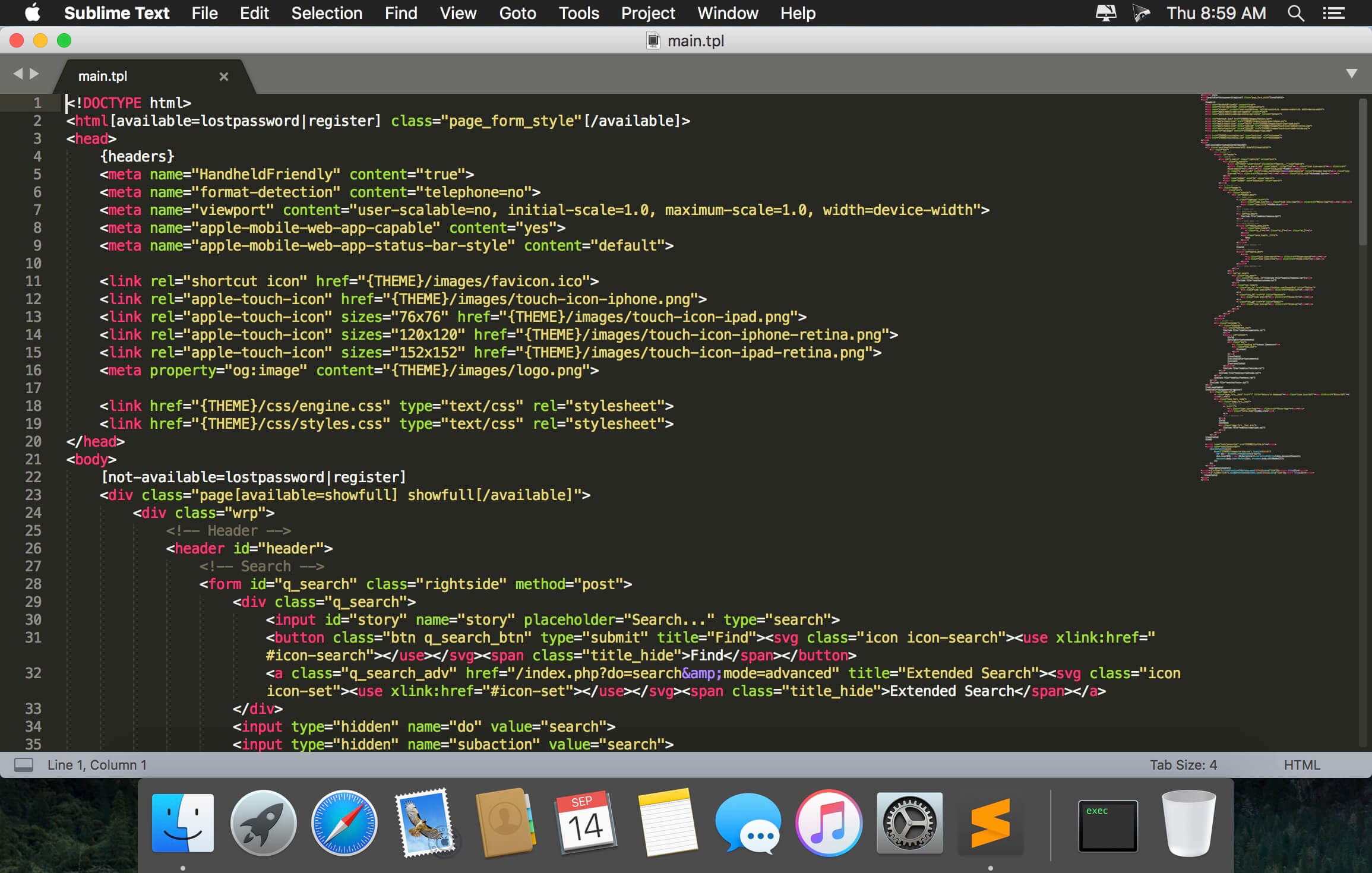Selections and Multiple Cursors in Sublime Text 3. A handy list of selection shortcuts. Here are the official docs: Keyboard and Mouse Mouse. Building blocks: Add to selection: Ctrl. 75 time-saving Hotkeys for Sublime Text. Extensive, exportable, wiki-style reference lists for Keyboard Shortcuts/Hotkeys.
- Sublime Text 4
- Sublime Text Editor Download Mac
- Download Sublime For Mac
- Download Sublime Text Mac
- Sublime Text 3 Free
- Sublime Text 3 For Mac
As I’m working in the OSX Terminal more and more these days, I'm always on the lookout for time saving shortcuts.
A really useful tip that I picked up recently from Zander Martineau is how to open up Sublime Text straight from the Terminal. This is done by hooking into a CLI utility that Sublime provides called subl.
The following instructions are based largely on the original gist on Github by Artero, so credit for this solution should be directed to them and not myself.
It’s a slightly different installation depending on whether you’re using Sublime Text 2 or 3, so I’ll split the two out below in the installaton; simply refer to the instructions that are relevant to you.
Installation
Assuming you installed Sublime in the Applications folder, the following command should open up the editor when you type it into the Terminal:
For Sublime Text 2:
open /Applications/Sublime Text 2.app/Contents/SharedSupport/bin/subl
For Sublime Text 3:
open /Applications/Sublime Text.app/Contents/SharedSupport/bin/subl
If that worked, you're good to go.
You now need to create a symlink called sublime which links the subl CLI to a folder where your system usually looks to execute these binaries. To do this, type in:
For Sublime Text 2:
ln -s /Applications/Sublime Text 2.app/Contents/SharedSupport/bin/subl /usr/local/bin/sublime
For Sublime Text 3:
ln -s '/Applications/Sublime Text.app/Contents/SharedSupport/bin/subl' /usr/local/bin/sublime
Check your profile
The final thing you need to do, is to check that your system profile is looking in the right place to see the symlink you have just created.
Enter the following command into your Terminal:
open ~/.bash_profile
Note that in some cases the profile may be called ~/.profile.
This should open up your profile in a text editor. What you’re looking for is a line towards the top of the file that starts with export PATH=. Your PATH contains all the directories that will be checked for executable binaries when you type a command into your Terminal. Since we created a symlink in the /usr/local/bin folder, we want to make sure that that folder is being checked too.
Hopefully, you’ll be able to see something similar to this:
export PATH=/usr/local/bin:(..)
Sublime Text 4
If not, simply add this folder to your PATH and save the file.
Note: The (..) in this example represents other folders that would be listed on the same line and separated by a colon.
If you don't already have a PATH set in your bash_profile you can type the following on a new line:


export PATH=/usr/local/bin:$PATH
Finally, if you did have to add /usr/local/bin to your PATH, run the following command before continuing:
Sublime Text Editor Download Mac
source ~/.bash_profile
This will reload your .bash_profile with the newly added directory in your PATH.
In the Microsoft Office 2011 14.6.3 Update volume window, double-click the Office 2011 14.6.3 Update application to start the update process, and then follow the instructions on the screen. If the installation finishes successfully, you can remove the update installer from your hard disk. Microsoft for mac 2011.
Test it works!
In your Terminal, the following commands should now work:
sublime .– opens the current directory in Sublimesublime filename– opens a file wherefilenameis the file to be openedsublime foldername– opens a folder wherefoldernameis the folder to be opened
And there you have it – you can now open any file or folder in Sublime straight from the Terminal.
Thanks and credit for this great solution again goes to Artero. If you have any problems getting it working, let me know and I’ll do my best to help you out.
Article posted on the 17th February 2014
Sublime Text 3 ships with a CLI called subl (why not 'sublime', go figure). This utility is hidden in the following folder (assuming you installed Sublime in /Applications like normal folk. If this following line opens Sublime Text for you, then bingo, you're ready.
open /Applications/Sublime Text.app/Contents/SharedSupport/bin/subl
You can find more (official) details about subl here: http://www.sublimetext.com/docs/3/osx_command_line.html
Installation
The official documentation I linked to above recommends creating a ~/bin folder (in your home directory). That's weird, I don't recall ever being asked to do that on OS X since most people install binaries within /usr/local/bin which – if you're a developer – is likely to already have tons of other binaries.
So contrary to the Sublime team recommendation, we're not going to create a bin folder in your home directory:
ln -s '/Applications/Sublime Text.app/Contents/SharedSupport/bin/subl' /usr/local/bin/sublime
See also SO Thread
This will simply create a symlink called sublime (remember, we like names that don't suck to type 500 times a day) between the subl binary stashed in the Sublime application package, and a folder where your system usually looks for binaries to execute (launch). Think of it as a wormhole of awesome.
Now let's do a check to see if everything will run smoothly. Enter this:
open ~/.bash_profile
Download Sublime For Mac
(In some cases the profile file is named ~/.profile) Mac os download for windows 10 free.
You should see at the top of the file a line that starts with:export PATH=
This contains all the directories that will be looked into for executable binaries when you type a command in Terminal. Since we create a symlink to subl called sublime in the /usr/local/bin directory let's check if this directory is listed on that same line.
If it is, perfect. Let's keep going. If not, simply add it like this and save the file:
export PATH=/usr/local/bin:(..)
Note: The '(..)' in this example represents other folders that would be listed on the same line and separated by a colon.
If you don't already have a PATH set in your bash_profile you can type:

export PATH=/usr/local/bin:$PATH
If you had to add /usr/local/bin to your PATH, run the following command before continuing:
source ~/.bash_profile

This will reload your .bash_profile with the newly added directory.

Testing
Open a Terminal window and run:
sublime filename (replace 'filename' by an actual file name) Miner for mac os x.
Download Sublime Text Mac
or
sublime foldername (replace 'foldername' by an actual folder name)
Sublime Text 3 Free
or even
Sublime Text 3 For Mac
sublime . (to open the entire current directory)
Conclusion
Now you don't need to get out of Terminal to simply open a file or a folder, you didn't have to add an 'alias' or yet another bin directory to your .bash_profile which you would have needed with the official instructions given by the Sublime team.
Have fun, Sublime is a great editor showing a lot of promise.

Comments are closed.